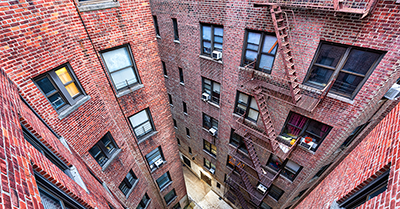
Redlining impact rears its ugly head again thanks to COVID-19
Low-income communities hit hardest by both virus and economic struggles
The COVID-19 pandemic has changed the American way of life as we knew it and has negatively impacted millions.
But no one group has felt a greater negative impact from the coronavirus than Black Americans.
Since the pandemic first forced the country to shut down last March, Black Americans have faced job loss, wage reduction, small business closures and community infections at a greater rate than any other race or ethnicity.
This has had a trickle-down effect on housing, as Black property owners and Black renters have struggled to make the financial payments necessary to keep roofs over their heads.
The struggle is real for Black developers as well, who after years of building their companies from the ground up on the shoulders of the need for affordable housing, are likely going to find themselves either shutting down operations or, in a best-case-scenario, starting all over again.
According to an article published by Bisnow, although 92.2 percent of market-rate apartment renters paid rent in June, nearly 25 percent of rent-stabilized units in New York did not.
This is an indicator that the nearly eight percent of renters in this country that aren’t able to afford their rent now because of the pandemic, are likely concentrated in specific areas of the country. And likelier still, into specific neighborhoods, or sections of major markets.
This is the result of ages old discrimination that the government tried to curb more than 50 years ago but is still impacting Black Americans today.
Redlining, which was a post-World-War II government mapping practice that basically segregated communities and allowed banks to discriminate against residents of predominantly Black neighborhoods when it came time to approve loans, was outlawed with the birth of the Fair Housing Act, signed into law in 1968.
However, while redlining doesn’t exist today, the effects of its impact on society more than a half century ago can still be felt, much like the aftershock of an earthquake.
Developers of color told Bisnow they still have hurdles to traverse today when getting loans to fund their projects. This often gets lost in the shuffle because there is a racial disparity when it comes to developers.
More than 13 percent of the country identifies as Black, only 1.3 percent of senior executives in commercial real estate are Black men and less than one percent are black women, according to a 2016 study from Florida A&M University.
Many Black developers have been able to build their business by either purchasing or building affordable housing. The draw toward affordable housing for Black developers is the result of the gap in wealth and equity that exists in America between whites and Blacks.
According to a report from the Brookings Institution in February, the average net worth of a white family is 10 times that of a Black family.
This disparity is largely the result of the housing policies that existed during pre- and post-World War II America.
Redlining, the practice of rating neighborhoods from most desirable to least desirable, ended up segregating Americans predominantly by race.
It became nearly impossible for people to get loans for the less desirable neighborhoods, and Black Americans were especially discriminated against, and couldn’t even become property owners in their own, segregated neighborhoods.
The Fair Housing Act of 1968 banned redlining, but the long-lasting impact of it is still felt more than 70 years later.
The homeownership gap in the United States between whites and Blacks is worse in 2020 than it was in 1968.
Add in the impact of COVID-19, and Black Americans are bearing the brunt of the damage economic damage being caused by the pandemic.
Not only were Black Americans more likely to be infected by the coronavirus and die from it, especially in major metropolitan areas where people live in much closer proximity to one another than in suburbs or even rural communities, but the neighborhoods that were hit hardest economically by the shutdown that occurred as the country tried to flatten the curve were in lower-income Black communities.
According to the Urban Institute, layoffs and furloughs from companies during the shutdown, adversely affected Black (and Latinx) workers, leading to more housing instability because these workers were more likely to be living paycheck-to-paycheck before the pandemic gripped the country.
In a city like New York, where whites are actually a minority, making up only 42.7 percent of the population, all of the city’s major developers and property owners are companies run by whites.
“I definitely think that COVID has shone a light on the lack of Black property ownership in the Black community,” Harlem-based Lemor Realty Corp. President Kenneth Morrison told Bisnow. “I live in the community my buildings are in, so when I walk the streets, I am walking by my property.
“There’s a difference when you don’t have that. It shows.”
Some developers are pushing for public funding that would help Black developers climb out of any financial hardships that are the result of the pandemic, but there is also hope brewing that the racial awakening America is currently experiencing may shed light on the inequalities in real estate – especially when it comes to developing commercial properties, and will effectuate needed change.
“I think folks are now recognizing what Black Americans have been going through,” Morrison said. “It’s not just prejudices at work, it is a system, and it is all coming to light. We’re seeing the economic conversations happen that should be happening.”
Time to Focus on Affordable Housing
Taxes on real estate are not the answer. Sign the petition calling on Congress to address our country’s housing shortage.





